ron NISSAN NOTE 2006 Owners Manual
[x] Cancel search | Manufacturer: NISSAN, Model Year: 2006, Model line: NOTE, Model: NISSAN NOTE 2006Pages: 235, PDF Size: 2.29 MB
Page 3 of 235
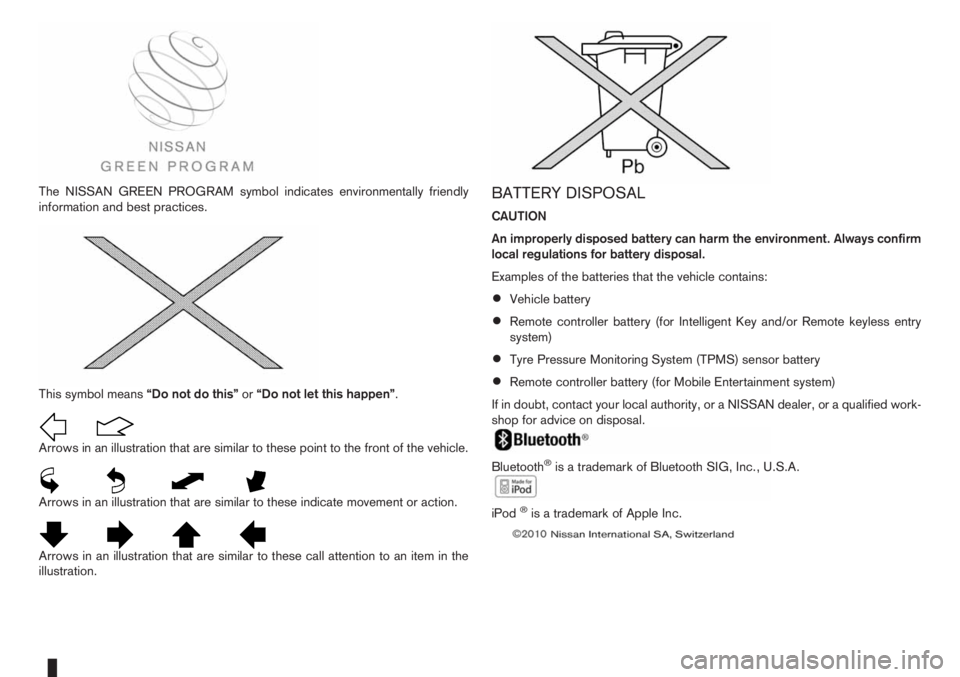
The NISSAN GREEN PROGRAM symbol indicates environmentally friendly
information and best practices.
This symbol means“Do not do this”or“Do not let this happen”.
Arrows in an illustration that are similar to these point to the front of the vehicle.
Arrows in an illustration that are similar to these indicate movement or action.
Arrows in an illustration that are similar to these call attention to an item in the
illustration.BATTERY DISPOSAL
CAUTION
An improperly disposed battery can harm the environment. Always confirm
local regulations for battery disposal.
Examples of the batteries that the vehicle contains:
•Vehicle battery
•Remote controller battery (for Intelligent Key and/or Remote keyless entry
system)
•Tyre Pressure Monitoring System (TPMS) sensor battery
•Remote controller battery (for Mobile Entertainment system)
If in doubt, contact your local authority, or a NISSAN dealer, or a qualified work-
shop for advice on disposal.
Bluetooth®is a trademark of Bluetooth SIG, Inc., U.S.A.
iPod®is a trademark of Apple Inc.
Page 7 of 235
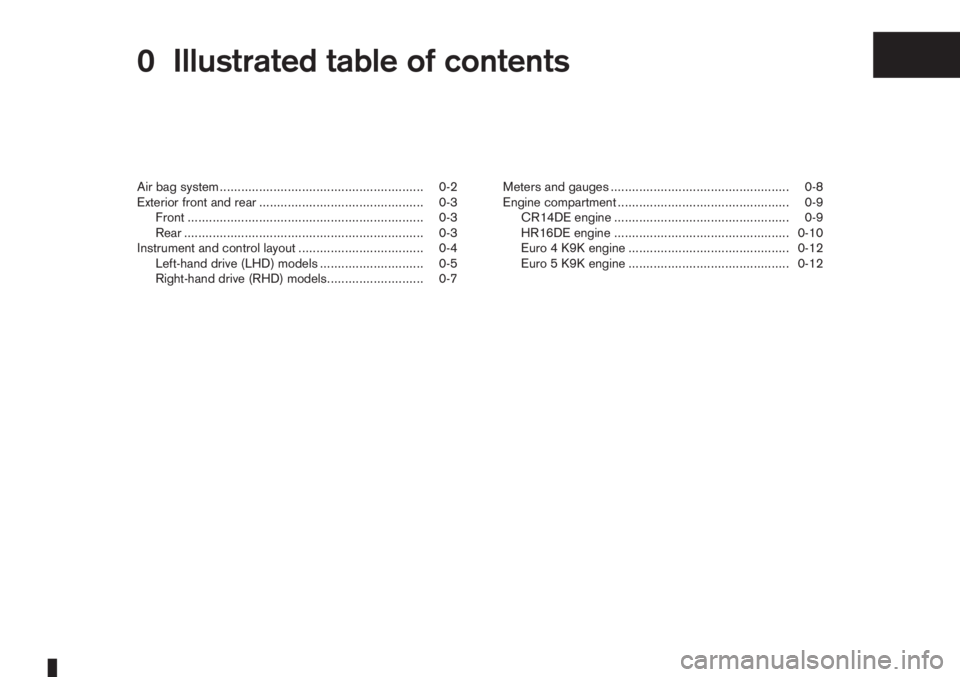
0Illustrated table of contentsIllustrated table of contents
Air bag system ......................................................... 0-2
Exterior front and rear .............................................. 0-3
Front .................................................................. 0-3
Rear ................................................................... 0-3
Instrument and control layout ................................... 0-4
Left-hand drive (LHD) models ............................. 0-5
Right-hand drive (RHD) models........................... 0-7Meters and gauges .................................................. 0-8
Engine compartment ................................................ 0-9
CR14DE engine ................................................. 0-9
HR16DE engine ................................................. 0-10
Euro 4 K9K engine ............................................. 0-12
Euro 5 K9K engine ............................................. 0-12
Page 8 of 235
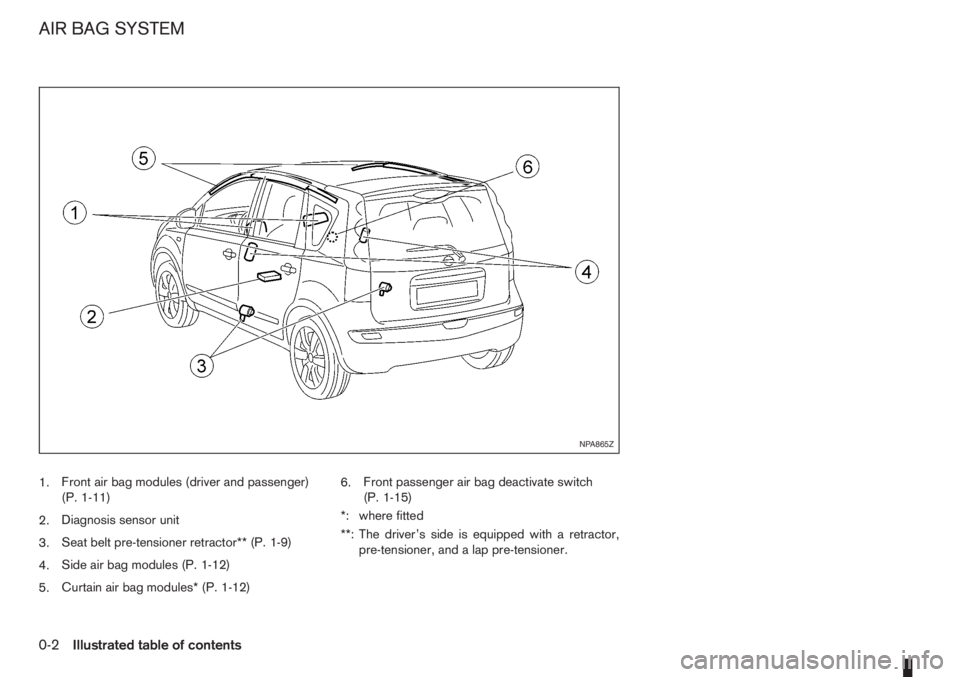
1.Front air bag modules (driver and passenger)
(P. 1-11)
2.Diagnosis sensor unit
3.Seat belt pre-tensioner retractor** (P. 1-9)
4.Side air bag modules (P. 1-12)
5.Curtain air bag modules* (P. 1-12)6.Front passenger air bag deactivate switch
(P. 1-15)
*: where fitted
**: The driver’s side is equipped with a retractor,
pre-tensioner, and a lap pre-tensioner.
NPA865Z
AIR BAG SYSTEM
0-2Illustrated table of contents
Page 9 of 235
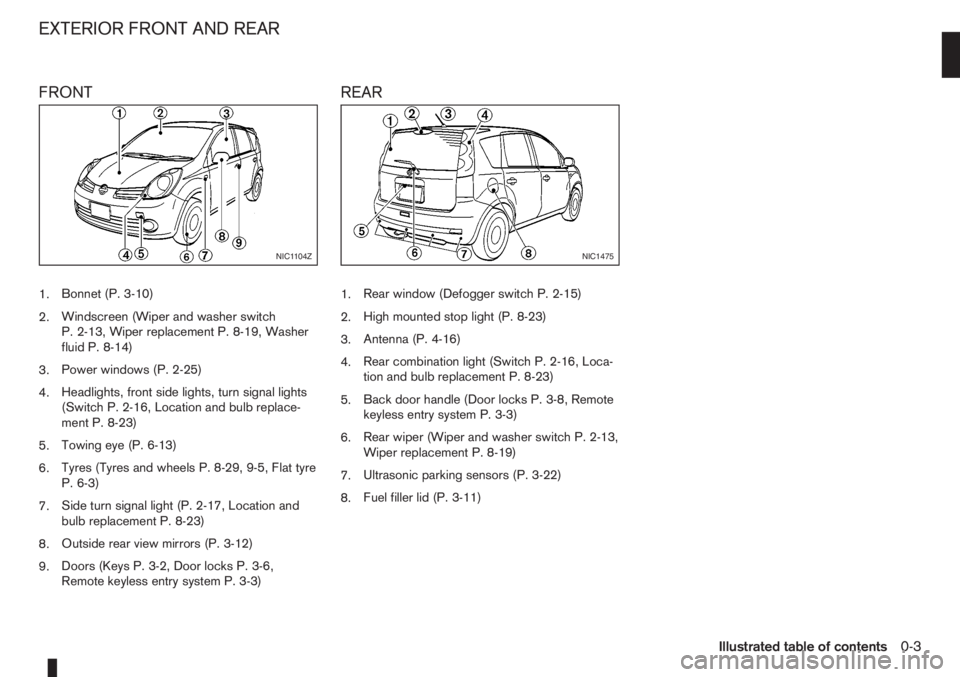
FRONT
1.Bonnet (P. 3-10)
2.Windscreen (Wiper and washer switch
P. 2-13, Wiper replacement P. 8-19, Washer
fluid P. 8-14)
3.Power windows (P. 2-25)
4.Headlights, front side lights, turn signal lights
(Switch P. 2-16, Location and bulb replace-
ment P. 8-23)
5.Towing eye (P. 6-13)
6.Tyres (Tyres and wheels P. 8-29, 9-5, Flat tyre
P. 6-3)
7.Side turn signal light (P. 2-17, Location and
bulb replacement P. 8-23)
8.Outside rear view mirrors (P. 3-12)
9.Doors (Keys P. 3-2, Door locks P. 3-6,
Remote keyless entry system P. 3-3)
REAR
1.Rear window (Defogger switch P. 2-15)
2.High mounted stop light (P. 8-23)
3.Antenna (P. 4-16)
4.Rear combination light (Switch P. 2-16, Loca-
tion and bulb replacement P. 8-23)
5.Back door handle (Door locks P. 3-8, Remote
keyless entry system P. 3-3)
6.Rear wiper (Wiper and washer switch P. 2-13,
Wiper replacement P. 8-19)
7.Ultrasonic parking sensors (P. 3-22)
8.Fuel filler lid (P. 3-11)
NIC1104ZNIC1475
EXTERIOR FRONT AND REAR
Illustrated table of contents0-3
Page 11 of 235
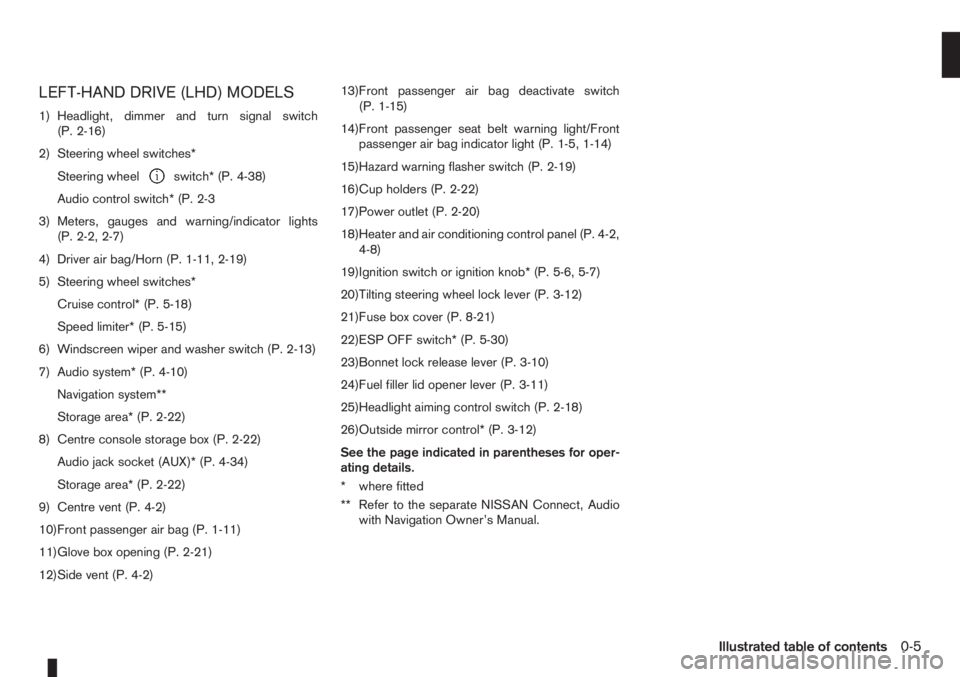
LEFT-HAND DRIVE (LHD) MODELS
1) Headlight, dimmer and turn signal switch
(P. 2-16)
2) Steering wheel switches*
Steering wheel
switch* (P. 4-38)
Audio control switch* (P. 2-3
3) Meters, gauges and warning/indicator lights
(P. 2-2, 2-7)
4) Driver air bag/Horn (P. 1-11, 2-19)
5) Steering wheel switches*
Cruise control* (P. 5-18)
Speed limiter* (P. 5-15)
6) Windscreen wiper and washer switch (P. 2-13)
7) Audio system* (P. 4-10)
Navigation system**
Storage area* (P. 2-22)
8) Centre console storage box (P. 2-22)
Audio jack socket (AUX)* (P. 4-34)
Storage area* (P. 2-22)
9) Centre vent (P. 4-2)
10)Front passenger air bag (P. 1-11)
11)Glove box opening (P. 2-21)
12)Side vent (P. 4-2)13)Front passenger air bag deactivate switch
(P. 1-15)
14)Front passenger seat belt warning light/Front
passenger air bag indicator light (P. 1-5, 1-14)
15)Hazard warning flasher switch (P. 2-19)
16)Cup holders (P. 2-22)
17)Power outlet (P. 2-20)
18)Heater and air conditioning control panel (P. 4-2,
4-8)
19)Ignition switch or ignition knob* (P. 5-6, 5-7)
20)Tilting steering wheel lock lever (P. 3-12)
21)Fuse box cover (P. 8-21)
22)ESP OFF switch* (P. 5-30)
23)Bonnet lock release lever (P. 3-10)
24)Fuel filler lid opener lever (P. 3-11)
25)Headlight aiming control switch (P. 2-18)
26)Outside mirror control* (P. 3-12)
See the page indicated in parentheses for oper-
ating details.
* where fitted
** Refer to the separate NISSAN Connect, Audio
with Navigation Owner’s Manual.
Illustrated table of contents0-5
Page 13 of 235
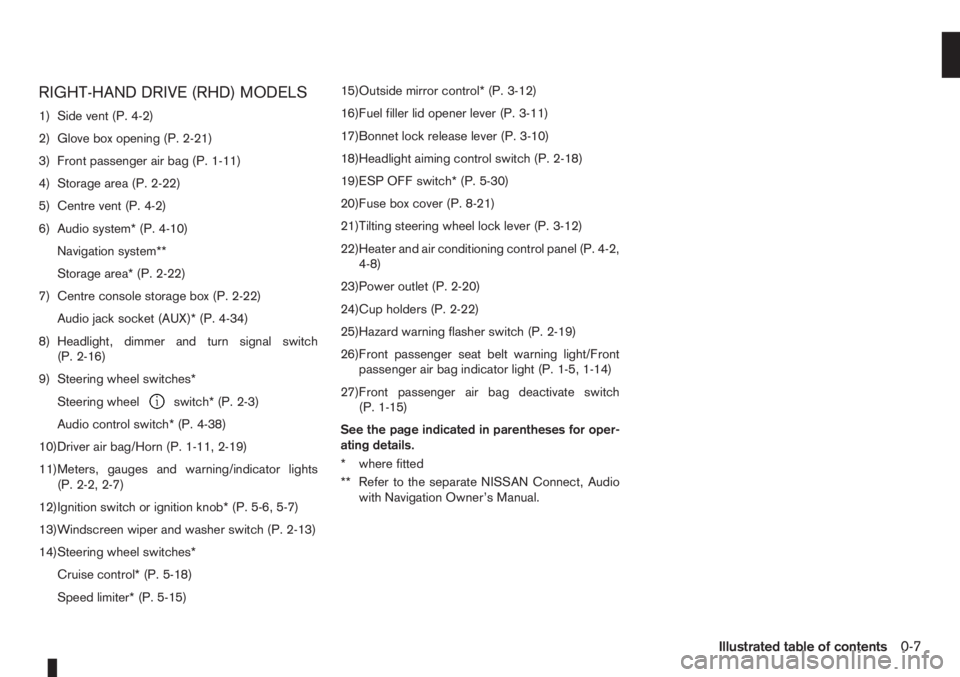
RIGHT-HAND DRIVE (RHD) MODELS
1) Side vent (P. 4-2)
2) Glove box opening (P. 2-21)
3) Front passenger air bag (P. 1-11)
4) Storage area (P. 2-22)
5) Centre vent (P. 4-2)
6) Audio system* (P. 4-10)
Navigation system**
Storage area* (P. 2-22)
7) Centre console storage box (P. 2-22)
Audio jack socket (AUX)* (P. 4-34)
8) Headlight, dimmer and turn signal switch
(P. 2-16)
9) Steering wheel switches*
Steering wheel
switch* (P. 2-3)
Audio control switch* (P. 4-38)
10)Driver air bag/Horn (P. 1-11, 2-19)
11)Meters, gauges and warning/indicator lights
(P. 2-2, 2-7)
12)Ignition switch or ignition knob* (P. 5-6, 5-7)
13)Windscreen wiper and washer switch (P. 2-13)
14)Steering wheel switches*
Cruise control* (P. 5-18)
Speed limiter* (P. 5-15)15)Outside mirror control* (P. 3-12)
16)Fuel filler lid opener lever (P. 3-11)
17)Bonnet lock release lever (P. 3-10)
18)Headlight aiming control switch (P. 2-18)
19)ESP OFF switch* (P. 5-30)
20)Fuse box cover (P. 8-21)
21)Tilting steering wheel lock lever (P. 3-12)
22)Heater and air conditioning control panel (P. 4-2,
4-8)
23)Power outlet (P. 2-20)
24)Cup holders (P. 2-22)
25)Hazard warning flasher switch (P. 2-19)
26)Front passenger seat belt warning light/Front
passenger air bag indicator light (P. 1-5, 1-14)
27)Front passenger air bag deactivate switch
(P. 1-15)
See the page indicated in parentheses for oper-
ating details.
* where fitted
** Refer to the separate NISSAN Connect, Audio
with Navigation Owner’s Manual.
Illustrated table of contents0-7
Page 19 of 235
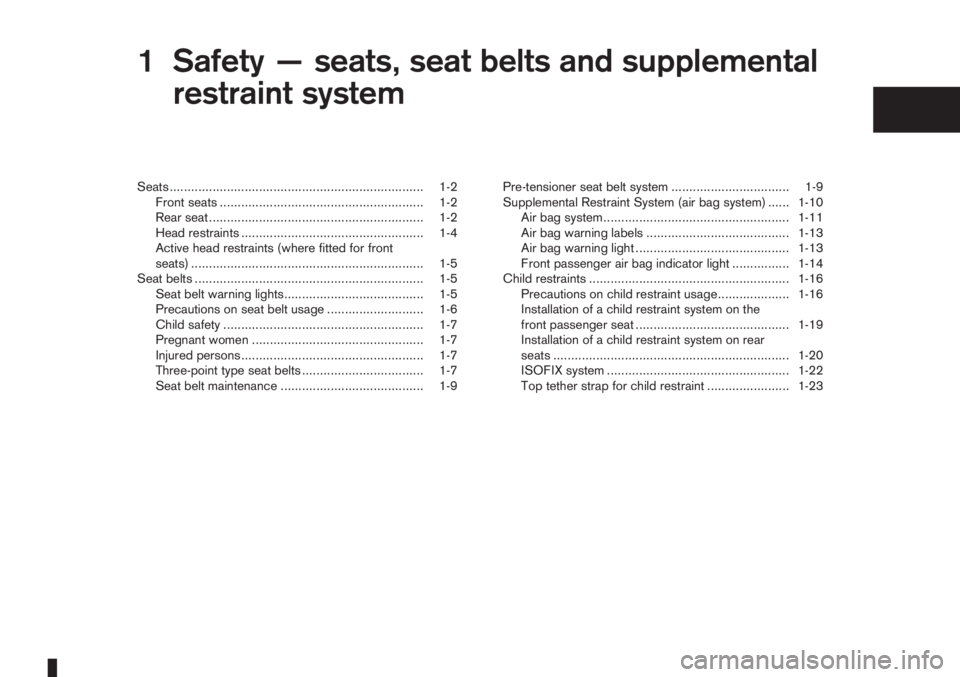
1Safety — seats, seat belts and supplemental
restraint systemSafety — seats, seat belts and supplemental
restraint system
Seats ....................................................................... 1-2
Front seats ......................................................... 1-2
Rear seat ............................................................ 1-2
Head restraints ................................................... 1-4
Active head restraints (where fitted for front
seats) ................................................................. 1-5
Seat belts ................................................................ 1-5
Seat belt warning lights....................................... 1-5
Precautions on seat belt usage ........................... 1-6
Child safety ........................................................ 1-7
Pregnant women ................................................ 1-7
Injured persons................................................... 1-7
Three-point type seat belts .................................. 1-7
Seat belt maintenance ........................................ 1-9Pre-tensioner seat belt system ................................. 1-9
Supplemental Restraint System (air bag system) ...... 1-10
Air bag system.................................................... 1-11
Air bag warning labels ........................................ 1-13
Air bag warning light ........................................... 1-13
Front passenger air bag indicator light ................ 1-14
Child restraints ........................................................ 1-16
Precautions on child restraint usage.................... 1-16
Installation of a child restraint system on the
front passenger seat ........................................... 1-19
Installation of a child restraint system on rear
seats .................................................................. 1-20
ISOFIX system ................................................... 1-22
Top tether strap for child restraint ....................... 1-23
Page 20 of 235
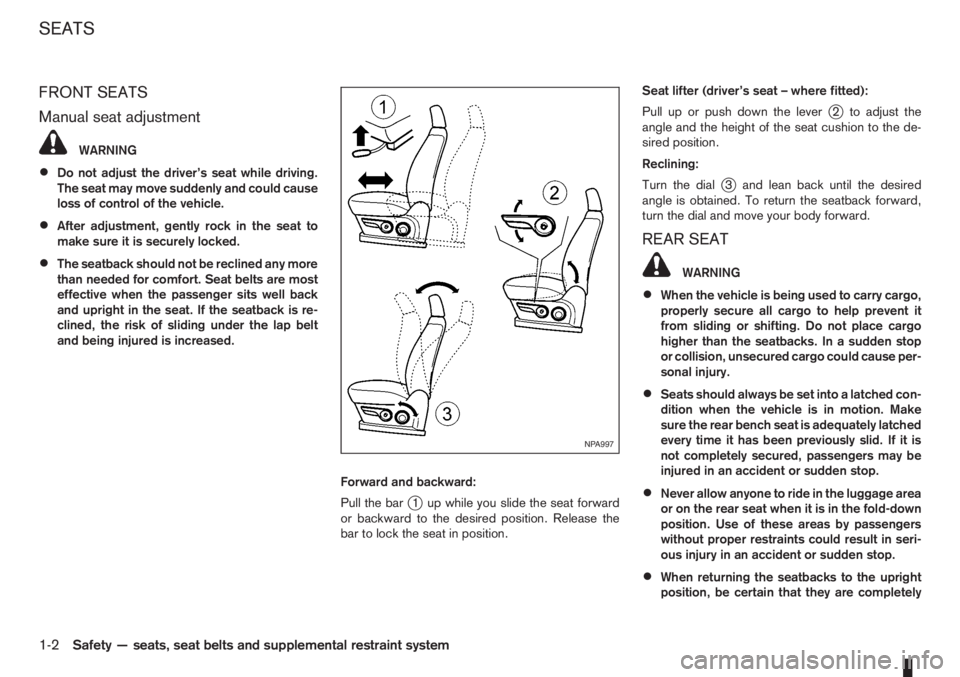
FRONT SEATS
Manual seat adjustment
WARNING
•Do not adjust the driver’s seat while driving.
The seat may move suddenly and could cause
loss of control of the vehicle.
•After adjustment, gently rock in the seat to
make sure it is securely locked.
•The seatback should not be reclined any more
than needed for comfort. Seat belts are most
effective when the passenger sits well back
and upright in the seat. If the seatback is re-
clined, the risk of sliding under the lap belt
and being injured is increased.
Forward and backward:
Pull the bar
j1 up while you slide the seat forward
or backward to the desired position. Release the
bar to lock the seat in position.Seat lifter (driver’s seat – where fitted):
Pull up or push down the lever
j2 to adjust the
angle and the height of the seat cushion to the de-
sired position.
Reclining:
Turn the dial
j3 and lean back until the desired
angle is obtained. To return the seatback forward,
turn the dial and move your body forward.
REAR SEAT
WARNING
•When the vehicle is being used to carry cargo,
properly secure all cargo to help prevent it
from sliding or shifting. Do not place cargo
higher than the seatbacks. In a sudden stop
or collision, unsecured cargo could cause per-
sonal injury.
•Seats should always be set into a latched con-
dition when the vehicle is in motion. Make
sure the rear bench seat is adequately latched
every time it has been previously slid. If it is
not completely secured, passengers may be
injured in an accident or sudden stop.
•Never allow anyone to ride in the luggage area
or on the rear seat when it is in the fold-down
position. Use of these areas by passengers
without proper restraints could result in seri-
ous injury in an accident or sudden stop.
•When returning the seatbacks to the upright
position, be certain that they are completely
NPA997
SEATS
1-2Safety — seats, seat belts and supplemental restraint system
Page 22 of 235
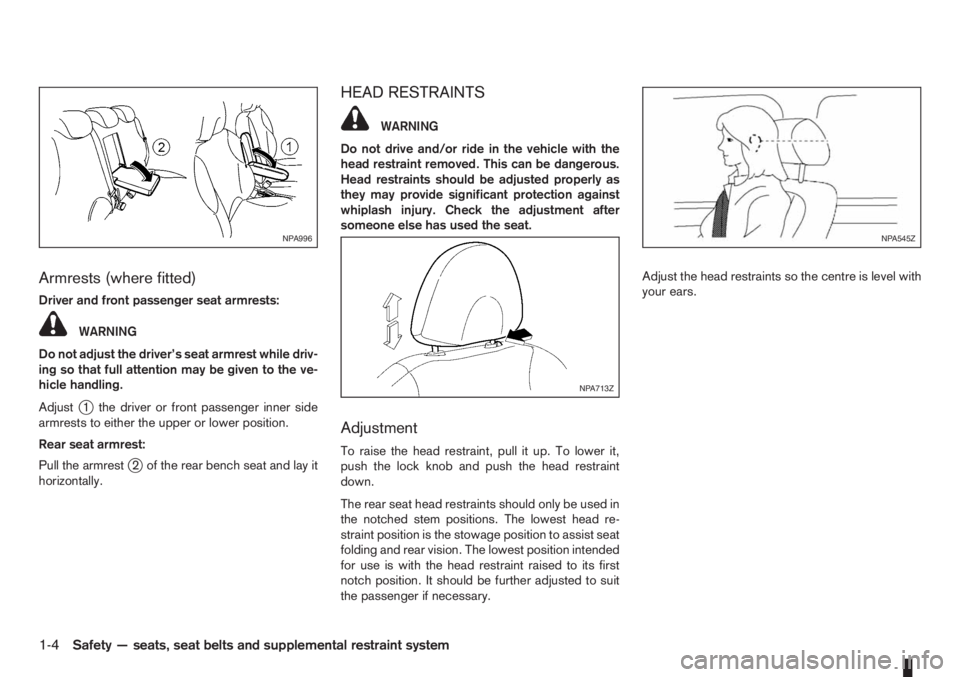
Armrests (where fitted)
Driver and front passenger seat armrests:
WARNING
Do not adjust the driver’s seat armrest while driv-
ing so that full attention may be given to the ve-
hicle handling.
Adjust
j1 the driver or front passenger inner side
armrests to either the upper or lower position.
Rear seat armrest:
Pull the armrest
j2 of the rear bench seat and lay it
horizontally.
HEAD RESTRAINTS
WARNING
Do not drive and/or ride in the vehicle with the
head restraint removed. This can be dangerous.
Head restraints should be adjusted properly as
they may provide significant protection against
whiplash injury. Check the adjustment after
someone else has used the seat.
Adjustment
To raise the head restraint, pull it up. To lower it,
push the lock knob and push the head restraint
down.
The rear seat head restraints should only be used in
the notched stem positions. The lowest head re-
straint position is the stowage position to assist seat
folding and rear vision. The lowest position intended
for use is with the head restraint raised to its first
notch position. It should be further adjusted to suit
the passenger if necessary.Adjust the head restraints so the centre is level with
your ears.
NPA996
NPA713Z
NPA545Z
1-4Safety — seats, seat belts and supplemental restraint system
Page 23 of 235
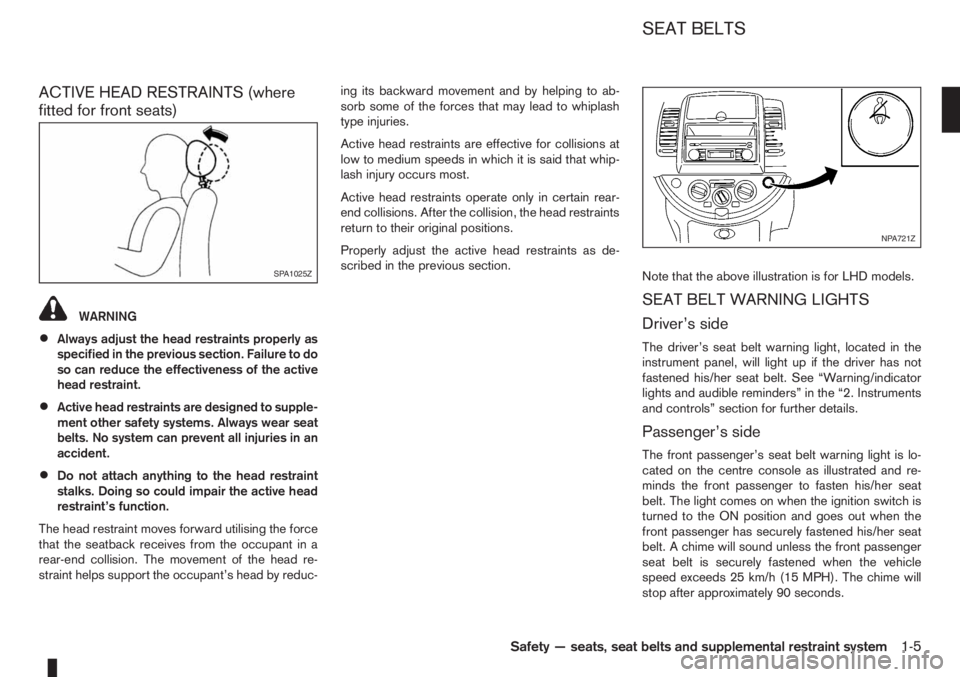
ACTIVE HEAD RESTRAINTS (where
fitted for front seats)
WARNING
•Always adjust the head restraints properly as
specified in the previous section. Failure to do
so can reduce the effectiveness of the active
head restraint.
•Active head restraints are designed to supple-
ment other safety systems. Always wear seat
belts. No system can prevent all injuries in an
accident.
•Do not attach anything to the head restraint
stalks. Doing so could impair the active head
restraint’s function.
The head restraint moves forward utilising the force
that the seatback receives from the occupant in a
rear-end collision. The movement of the head re-
straint helps support the occupant’s head by reduc-ing its backward movement and by helping to ab-
sorb some of the forces that may lead to whiplash
type injuries.
Active head restraints are effective for collisions at
low to medium speeds in which it is said that whip-
lash injury occurs most.
Active head restraints operate only in certain rear-
end collisions. After the collision, the head restraints
return to their original positions.
Properly adjust the active head restraints as de-
scribed in the previous section.
Note that the above illustration is for LHD models.
SEAT BELT WARNING LIGHTS
Driver’s side
The driver’s seat belt warning light, located in the
instrument panel, will light up if the driver has not
fastened his/her seat belt. See “Warning/indicator
lights and audible reminders” in the “2. Instruments
and controls” section for further details.
Passenger’s side
The front passenger’s seat belt warning light is lo-
cated on the centre console as illustrated and re-
minds the front passenger to fasten his/her seat
belt. The light comes on when the ignition switch is
turned to the ON position and goes out when the
front passenger has securely fastened his/her seat
belt. A chime will sound unless the front passenger
seat belt is securely fastened when the vehicle
speed exceeds 25 km/h (15 MPH). The chime will
stop after approximately 90 seconds.
SPA1025Z
NPA721Z
SEAT BELTS
Safety — seats, seat belts and supplemental restraint system1-5